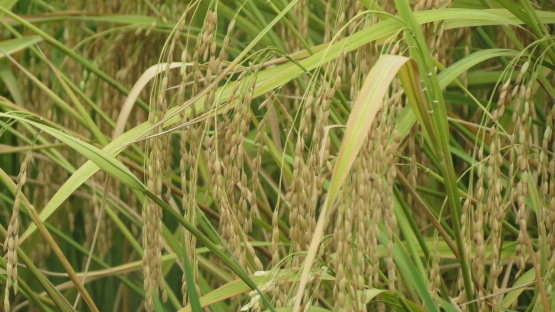The IAEA is launching a new Coordinated Research Project (CRP) on radiation-induced crop diversity and genetic associations, with a time frame of five years from 2022 to 2026.
Induced genetic diversity and breeding with promising mutations for farmer-preferred traits in agronomically sound genetic backgrounds have paved the way for crop improvement across the globe for over seven decades now. Testament to this is the more than 3300 mutant varieties in over 220 plant species from more than 70 countries represented in the Mutant Variety Database.
Induced mutations fortify plant germplasm pools and enable faster genetic gain, especially where the genetic base is narrow. Mutation breeding thus has the potential to facilitate larger genetic gain than conventional breeding. This advantage, coupled with emerging front end technologies for efficient and precise selection, can both accelerate the pace of crop improvement and increase the rate of genetic gain.
Breeding with induced genetic diversity has remained a highly effective avenue for the improvement of both simple and complex crop traits in developing Member States of the Food and Agriculture Organization of the United Nations (FAO) and the IAEA.
“Mutation breeding has so far mainly relied on gamma rays,” says Shoba Sivasankar, Head of the IAEA’s Plant Breeding and Genetics Section. “Most recently the ion beam, electron beam, proton beam and space irradiation — cosmic rays — are coming into increasing use at least in some countries, though the effect of these different sources on the plant genome remain to be assessed systematically.”
Newer genomic technologies that establish genetic associations for marker and candidate gene discovery are also yet to be applied to mutation breeding for increased precision and breeding efficiency. Mutant populations generated from induced genetic variation are traditionally used directly as source germplasm for breeding and variety development. However, they can also render themselves to the establishment of genetic associations for marker-assisted breeding and gene editing. Theoretically, mutant populations can also be used for genomic predictions for increased efficiency of the breeding process.
Technical support of the Joint FAO/IAEA Centre of Nuclear Techniques in Food and Agriculture has led to capacity building in crop improvement and the development of improved varieties in more than a hundred Member States since 1964. This technical support has centred on mutation induction, phenotypic selection and variety development, advancing very recently to explore molecular markers for increased precision in selection and efficiency in breeding.
The proposed CRP is aimed at addressing three important emerging trends and needs in the field of mutation breeding: (1) newer mutagen sources; (2) establishment of genetic associations for marker-assisted breeding, gene editing, and potentially, genomic selection; and (3) bioinformatic platforms and computational tools for trait analysis.
CRP Overall Objective
To strengthen the ability of the Agency and its Member States to develop and test emerging technologies in mutation induction, genomics and big data to facilitate the accelerated development of crop varieties for food security and climate change adaptation.
Specific Research Objectives
- To assess the nature of mutations induced by different mutagen sources, including gamma rays, ion beam, proton beam, electron beam and cosmic radiation.
- To determine molecular variant(s) underlying mutations for marker-assisted breeding.
- To confirm at least one mutant phenotype using gene editing. Focus will be on seed crops, diploid genomes and simple traits.
- To develop a test case to effectively apply genomic selection in mutation breeding.
- To identify novel mutants for crop-trait combinations included in the project.
- To develop/adapt reproducible computational tools and platforms to determine genetic associations.
Outputs
- Mutant population(s) generated from different mutagen sources for discovery research and variety development.
- Data on effect of different mutagen sources on the genome (i.e. nature and frequency of mutations).
- Molecular variants underlying mutations determined for use as markers in molecular breeding or as candidate genes in gene editing.
- Bioinformatic platform(s) developed/adapted for genetic association, genomic prediction.
- Improved mutant lines identified for traits of interest.
- Scientific publications in high impact journals.
- Protocols and training manuals developed and disseminated.
How to join this CRP
Up to three research/technical contracts are expected to be awarded on the study of the effect of mutagen sources on crop genome, five to six research/technical contracts on the study of genetic associations in established, structured plant populations built on clear phenotypes for simple traits (one or few genes expected to be involved), and one research/technical contract addressing genomic selection in mutation breeding. Proposals submitted on the study of genetic associations are encouraged to include data on expression of the phenotype and the status of populations amenable for genetic analysis. Up to five no-cost agreement holders from advanced laboratories are also expected to participate. Research institutes with recognized expertise in the targeted technologies will be invited to share their experience with the contract holders and contribute to the development and validation of the planned technical packages. Coordination and technical management will be handled by the scientific secretary in the IAEA’s Plant Breeding and Genetics Section with involvement of the Plant Breeding and Genetics Laboratory.
Please submit your Proposal for Research Contract or Agreement by email, no later than 15 December 2021, to the IAEA’s Research Contracts Administration Section, using the appropriate template on the CRA web portal. Same form can be used for the research contract and the technical contract.
For further information related to this CRP, potential applicants should use the contact form under the CRP page.


